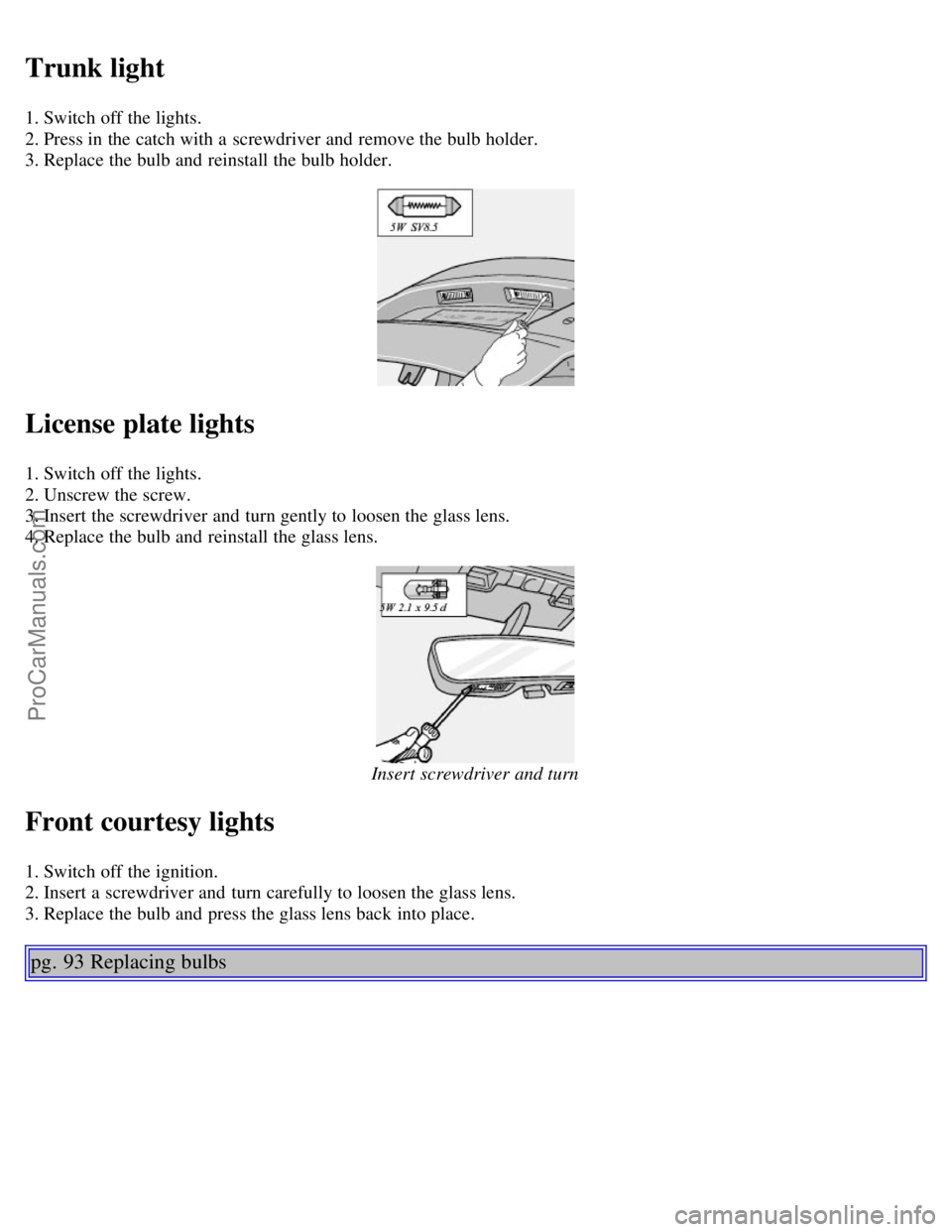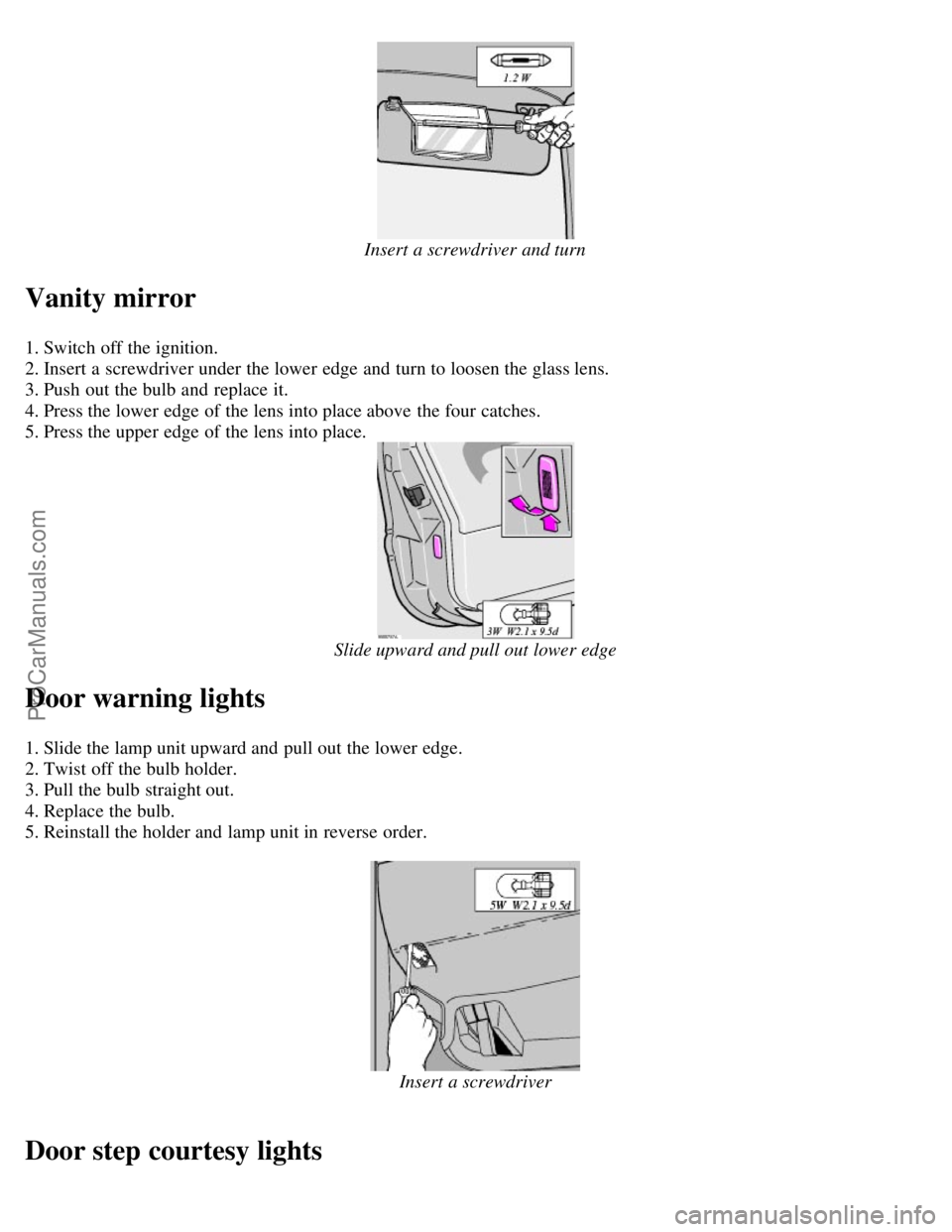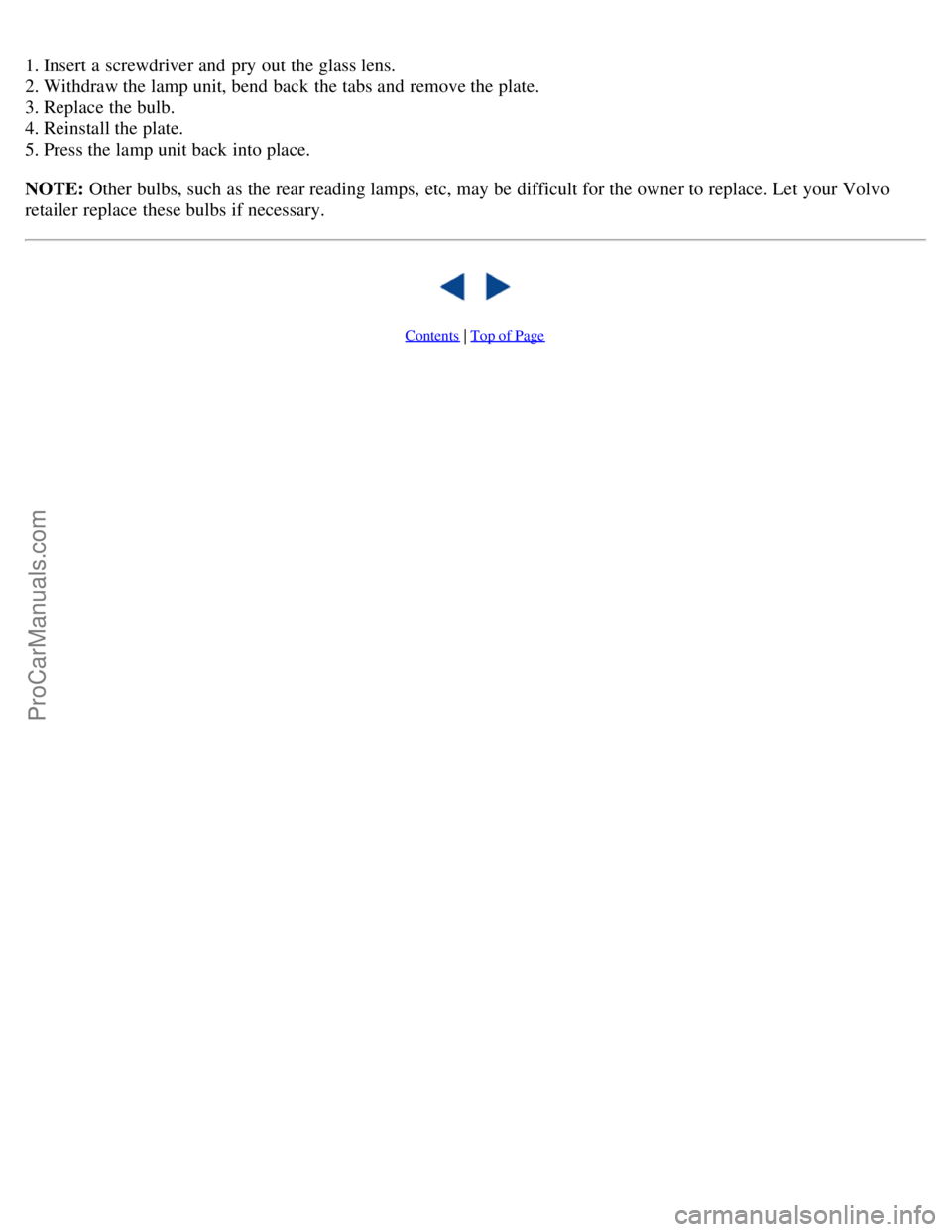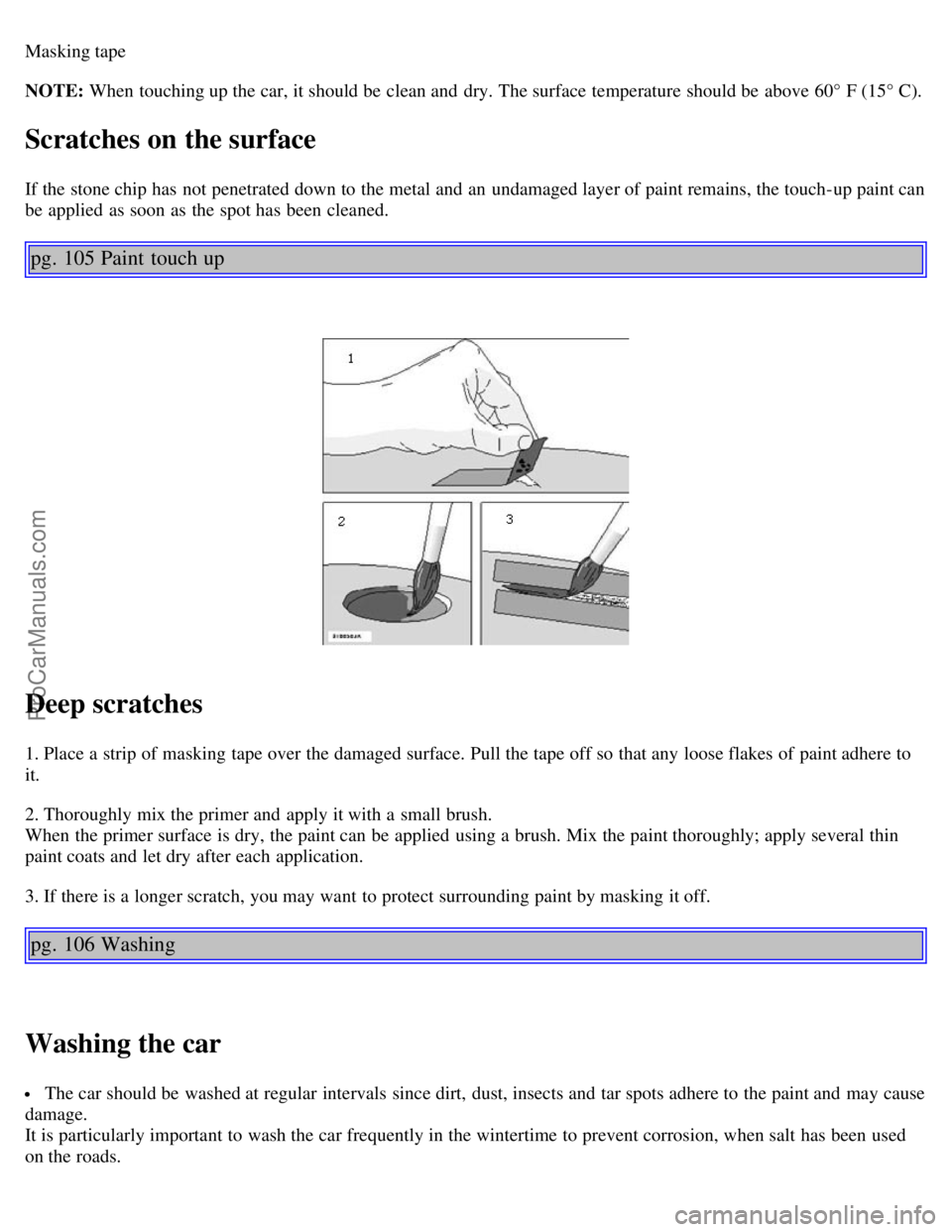VOLVO C70 2004 Workshop Manual
Manufacturer: VOLVO, Model Year: 2004, Model line: C70, Model: VOLVO C70 2004Pages: 99, PDF Size: 1.79 MB
Page 51 of 99

illustration on the following page.
Jack attachment
There is a jack attachment located in the center on each side of the car. Position the jack on the bar in the attachment
as shown in illustration above and crank while simultaneously guiding the base of the jack to the ground. The base of
the jack must be flat on a level, firm, non-slippery surface. Before raising the car, check that the jack is still
correctly positioned in the attachment.
WARNING!
The jack's attachment must engage the bar in the jack attachment (see inset illustration above). The car's weight must
not rest on the jack attachment.
Raise the vehicle until both wheels on the side of the car where the jack is attached are lifted off the ground. Unscrew
the wheel bolts completely and carefully remove the wheel so as not to damage the thread on the studs.
NOTE: To avoid excessive wear and the necessity of rebalancing, mark and reinstall wheels in the same location and
position as before removal. To lessen the chance of imbalance, each wheel hub is equipped with a guide stud to ensure
that a removed wheel can be reinstalled in its original position (as when changing over to winter tires/wheels).
CAUTION: The car must not be driven with wheels of different dimensions or with a spare tire other than the one that
came with the car. The use of different size wheels can seriously damage your car's transmission.
pg. 87 Wheel changing
WARNING!
The jack's attachment must engage the bar in the jack attachment (see inset illustration in center column on the
previous page. The car's weight must not rest on the jack attachment.
Be sure the jack is on a firm, level, non-slippery surface.
Never allow any part of your body to be extended under a car supported by a jack.
Use the jack intended for the car when replacing a wheel. For any other job, use stands to support the side of the
car being worked on.
Apply the parking brake, select position P (automatic transmission) or Reverse gear (manual transmission).
Block the wheels standing on the ground, use rigid wooden blocks or large stones.
The jack should be kept well-greased.
Installing the wheel
ProCarManuals.com
Page 52 of 99

Clean the contact surfaces on the wheel and hub. Lift the wheel and place it on the hub. Make sure that you align the
wheel with the guide stud on the wheel hub prior to installation. Install the wheel bolts crosswise (see illustration) and
tighten by turning lightly clockwise. Lower the vehicle to the ground and alternately tighten the bolts to 100 ft. lbs.
(130 Nm). Install the wheel cap (where applicable).
CAUTION: Correct tightening torque on wheel bolts must be observed. The wheel bolts should never be greased or
lubricated. The extended, chromed wheel bolts must not be used with steel rims, as they make it impossible to fit the
hub caps.
Correct tightening order for wheel bolts
pg. 88 Spare tire
Temporary Spare (certain models)
The spare tire in your car is called a "Temporary Spare". It has the following designation: T125/90 R15.
Recommended tire pressure (see decal on fuel filler flap) should be maintained irrespective of which position on the
car the Temporary Spare tire is used on.
In the event of damage to this tire, a new one can be purchased from your Volvo retailer.
CAUTION: The car must not be driven with wheels of different dimensions or with a spare tire other than the one that
came with the car. The use of different size wheels can seriously damage your car's transmission.
WARNING!
Current legislation prohibits the use of the "Temporary Spare" tire other than as a temporary replacement for a
punctured tire. In other words, it must be replaced as soon as possible by a standard tire. Roadholding, etc., may be
affected with the "Temporary Spare" in use. Do not, therefore, exceed 50 mph (80 km/h).
pg. 89 Replacing bulbs
ProCarManuals.com
Page 53 of 99

Parking light/direction indicator
1. From the front of the car, use a screwdriver to press down on the silver catch (located in the space between the
inside of the fender and the headlight unit) to release the lamp housing from the front fender.
2. Turn the bulb holder 1/4 turn clockwise (viewed from the front) and withdraw it from the from the lamp housing.
Leave the connector with its wires in the bulb holder.
4. Remove the bulb from the holder by pulling it straight out.
5. Press a new bulb into the holder and reinstall the unit in the reverse order.
Side direction indicator
1. Slide the lens forward and pull out the rear edge.
2. Pull out the entire lens/bulb unit.
3. With the lens toward you, turn the bulb holder 1/4 turn (the wires should not be disconnected from the holder) and
pull out the bulb holder from the lens unit.
ProCarManuals.com
Page 54 of 99

4. Pull the old bulb straight out and press a new one into place.
5. Replace the entire unit in the reverse order.
pg. 90 Replacing bulbs
A - Low beam Bulbs (high and low beams) - H7 B - High beam
Low beam headlight bulb (A) replacement
1. Turn the plastic cover counterclockwise and remove it.
2. Press the wire catches on the retaining clamp (1 in inset illustration above) together and push out (2) to release the
bulb and connector from the headlight housing.
3. Pull the bulb out of the connector.
4. Insert a new bulb into the connector.
5. Reinsert the bulb and connector into the headlight housing. The guide lug must be up to ensure proper positioning.
6. Press the retaining clamp back into position.
7. Reinstall the plastic cover. The marking "Top" on the cover should be up when the cover is reinstalled.
High beam headlight bulb (B) replacement
1. Pull the catch on the lower edge of the cover upward and remove the plastic cover.
2. Press the wire catches on the retaining clamp (1 in inset illustration above) together and push out (2) to release the
bulb and connector from the headlight housing.
3. Pull the bulb out of the connector.
4. Insert a new bulb into the connector.
5. Reinsert the bulb and connector into the headlight housing. The guide lug must be up to ensure proper positioning.
6. Press the retaining clamp back into position.
7. Reinstall the plastic cover. Catch B should snap into position.
Caution:
Do not touch the glass on halogen bulbs with your fingers. Grease, oil or any other impurities can be carbonized onto
the bulb and cause damage to the reflector.
Be sure to use bulbs of the correct type and voltage.
ProCarManuals.com
Page 55 of 99

pg. 91 Replacing bulbs
Tail light bulbs
1. Tail light
2. Direction indicator
3. Brake light
4. Tail light
5. Back-up light
6. Rear fog light (left side only)
All the bulbs in the tail light unit are replaced from inside the trunk as follows:
1. Turn the plastic screw and remove the cover over the rear lamp unit.
2. Remove the wing nut and remove the bulb holder.
3. Let the connector with its wires remain attached to the bulb holder.
4. Remove the bulb by pressing in and turning counterclockwise.
5. Insert a new bulb into the holder and reinstall the holder into the tail light assembly.
6. Close the cover.
pg. 92 Replacing bulbs
Insert screwdriver and turn
ProCarManuals.com
Page 56 of 99

Trunk light
1. Switch off the lights.
2. Press in the catch with a screwdriver and remove the bulb holder.
3. Replace the bulb and reinstall the bulb holder.
License plate lights
1. Switch off the lights.
2. Unscrew the screw.
3. Insert the screwdriver and turn gently to loosen the glass lens.
4. Replace the bulb and reinstall the glass lens.
Insert screwdriver and turn
Front courtesy lights
1. Switch off the ignition.
2. Insert a screwdriver and turn carefully to loosen the glass lens.
3. Replace the bulb and press the glass lens back into place.
pg. 93 Replacing bulbs
ProCarManuals.com
Page 57 of 99

Insert a screwdriver and turn
Vanity mirror
1. Switch off the ignition.
2. Insert a screwdriver under the lower edge and turn to loosen the glass lens.
3. Push out the bulb and replace it.
4. Press the lower edge of the lens into place above the four catches.
5. Press the upper edge of the lens into place.
Slide upward and pull out lower edge
Door warning lights
1. Slide the lamp unit upward and pull out the lower edge.
2. Twist off the bulb holder.
3. Pull the bulb straight out.
4. Replace the bulb.
5. Reinstall the holder and lamp unit in reverse order.
Insert a screwdriver
Door step courtesy lights
ProCarManuals.com
Page 58 of 99

1. Insert a screwdriver and pry out the glass lens.
2. Withdraw the lamp unit, bend back the tabs and remove the plate.
3. Replace the bulb.
4. Reinstall the plate.
5. Press the lamp unit back into place.
NOTE: Other bulbs, such as the rear reading lamps, etc, may be difficult for the owner to replace. Let your Volvo
retailer replace these bulbs if necessary.
Contents | Top of Page
ProCarManuals.com
Page 59 of 99

2 0 0 4
VOLVO C70
Chapter 7 - Car care
pg. 103 Car care
Page
Paint touch-up 104
Washing106
Cleaning the convertible top, Polishing and waxing107
Cleaning the upholstery108
pg. 104 Paint touch up
Paint touch-up
Paint damage requires immediate attention to avoid rusting. Make it a habit to check the finish regularly when washing
the car for instance. Touch-up if necessary.
Paint repairs require special equipment and skill. Contact your Volvo retailer for any extensive damage.
Minor scratches can be repaired by using Volvo touch-up paint.
NOTE: When ordering touch-up paint from your Volvo retailer, use the paint code indicated on the model plate. The
plate is located in the engine compartment, on the inside of the left front fender.
Minor stone chips and scratches
Material:
Primer - can
Paint - touch-up bottle
Brush
ProCarManuals.com
Page 60 of 99

Masking tape
NOTE: When touching up the car, it should be clean and dry. The surface temperature should be above 60° F (15° C).
Scratches on the surface
If the stone chip has not penetrated down to the metal and an undamaged layer of paint remains, the touch-up paint can
be applied as soon as the spot has been cleaned.
pg. 105 Paint touch up
Deep scratches
1. Place a strip of masking tape over the damaged surface. Pull the tape off so that any loose flakes of paint adhere to
it.
2. Thoroughly mix the primer and apply it with a small brush.
When the primer surface is dry, the paint can be applied using a brush. Mix the paint thoroughly; apply several thin
paint coats and let dry after each application.
3. If there is a longer scratch, you may want to protect surrounding paint by masking it off.
pg. 106 Washing
Washing the car
The car should be washed at regular intervals since dirt, dust, insects and tar spots adhere to the paint and may cause
damage.
It is particularly important to wash the car frequently in the wintertime to prevent corrosion, when salt has been used
on the roads.
ProCarManuals.com